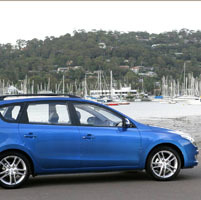
Over twenty years ago Alan Bond first started importing Hyundai’s in Australia. If you’d said then that by 2009, Korean manufacturer Hyundai would be a genuine global automotive force, with tentacles deep into the European, North American, Asian and Australian markets, someone would have said, ‘…you’re dreamin’ mate.’
How things have changed from the day of the first Excel, with Hyundai’s model range now almost touching every part of the automotive spectrum.
Having not ever reached again that freakish month where the Excel Mark II beat Holden Commodore for number one spot back in the nineties – Hyundai is increasing its market share. Number two in small car sales in this country, and closing on the Yaris at number one, is the Getz. The highly-awarded i30 is powering along in its segment with sales up 68.7 percent, year to date. Hyundai’s performance and acceptance as a brand is little short of remarkable.
When I was young (not long ago in case you’re wondering), I wasn’t exactly falling over myself to get into a Hyundai. Now that brand perception has changed – I would now go as far to say that the Hyundai brand is a maker of good value, genuinely competitive, smaller cars. A brand that you would mention in the same breath as Japanese or some Euro brands.
It’s true, Hyundai have always offered value for money, but where was that turning point made? I believe it was the i30. Sure, the Getz is a great little entry-level purchase, but the i30 represents a new chapter for Hyundai – soon to be followed by the upcoming i20 supermini and joined by the overseas Genesis sedan and Genesis Coupe models.
Now, to make the most of its success with the award-winning i30 hatch, and to give buyers a strong choice in the limited light wagon segment, Hyundai has delivered the i30cw – or ‘crossover wagon’ (not quite sure what it crosses over with, though).
Up front, the i30cw carries the same European style (it was designed in Germany) as its hatch counterpart. It’s at the very back that the i30cw comes into its own, where stylish tail lights dominate the visual space, replacing the Mercedes-Benz style units of the i30 hatch.
While the SX CRDi wears 16-inch factory wheels clad in simple hub caps, the range-topping petrol Sportswagon gets a set of 17-inch split five-spoke alloy rims, featuring unique polished inserts to the inside of each split spoke.
While the SX’s dash is let down by the absence of any colour but black (‘you can have any colour you want, as long as it’s black’ …thanks Henry Ford), the petrol Sportswagon benefits from lashings of aluminium-effect plastic on the steering wheel, centre stack and around the leather-wrapped shift knob, which itself gets a dash of chrome.
Sportswagon buyers will be pleased by the good quality leather seats and leather-wrapped steering wheel with wheel-mounted controls, a welcome premium feel over the SX’s fabric seats, plain black dash, rubber gear knob and synthetic steering wheel grip.
Space is what the i30cw offers. – with 415 litres of storage with the 60/40 split fold rear seats up, and 1395 litres with them down. And that’s the i30cw’s main draw card. With such excellent storage capacity and fuel economy that blows away any SUV, the i30cw will be appealing to anyone on a budget – or simply mindful of the cost of running an SUV.
Hyundai acknowledges that the wagon market in Australia (there are 25 wagons available here) amounts to less than one percent of the total market, but Oliver Mann, Hyundai’s General Manager of Marketing, points out that 35 percent of SUV owners don’t use their vehicle’s AWD capability, and that’s exactly the buyer Hyundai is aiming the i30cw at.
The SX offers air conditioning, but it’s the range-topping Sportswagon that gets fully automated climate control. For the Sportswagon, wheel-mounted cruise control comes as standard, and can be optioned in the SX – a most if you intend to use it for longer trips.
A six-speaker sound system, including tweeters, features in the Sportswagon, while the SX gets the requisite four speakers, while the customary iPod integration and auxiliary inputs feature in both trims.
The i30cw Sportswagon also features trip computer with distance to empty, trip distance and instant fuel consumption, automatic headlights, rain-sensing wipers and rear parking sensors as standard, while SX owners must simply learn to live without such luxuries.
For safety, the i30cw comes with ABS with Electronic Brakeforce Distribution (EBD), ESP and Traction Control as standard. Driver and front passenger airbags are standard in both trims, while driver and front passenger side (thorax) airbags and side curtain airbags are standard in the Sportswagon and available as an option in the SX.
With the 1.6 litre turbo diesel’s 255Nm of torque available the i30cw SX CRDi is punchier than its 85kW maximum output – would suggest. It’s deceiving, really: the i30cw weighs in at a relatively portly 1445kg, and 255Nm of torque isn’t much, but it easily cuts the mustard in this little wagon.
It’s when you’re stopped at the traffic lights that the i30cw SX CRDi is betrayed a little by its price point, with the rattle of the diesel more than a little audible. When those pesky pedestrians finish crossing and you get your long-awaited green light, the rattle settles down nicely to a much smoother hum.
While the petrol i30cw Sportswagon we tested was an automatic (and struggled a little if pressed), the SX CRDi was paired with a smooth five-speed manual transmission.
The first impression of the petrol-drinking i30cw is one of serenity. Inside, windows up, this car is very quiet at idle. The diesel’s no tractor, but the petrol feels a lot more upmarket thanks to its vibration-free nature.
Everyone says it, and we’re happy to say it too. The i30cw is a good buy that is quite good looking, drives well, and it seems solidly put together.
My recommendation would be to go the diesel. It is well-priced and the performance edge from the willing ‘oiler’ up front puts it ahead of the slightly breathless petrol model.
Starting at $20,890 for the i30cw SX 2.0 petrol five-speed manual through to the range-topping Sportswagon 2.0 petrol four-speed auto at $29,990 (the SX 1.6 CRDi turbo diesel five-speed manual we tested is $23,390 – all prices before on-road costs), Hyundai’s i30cw is possibly the best value small to medium wagon on the road at the moment.
***





